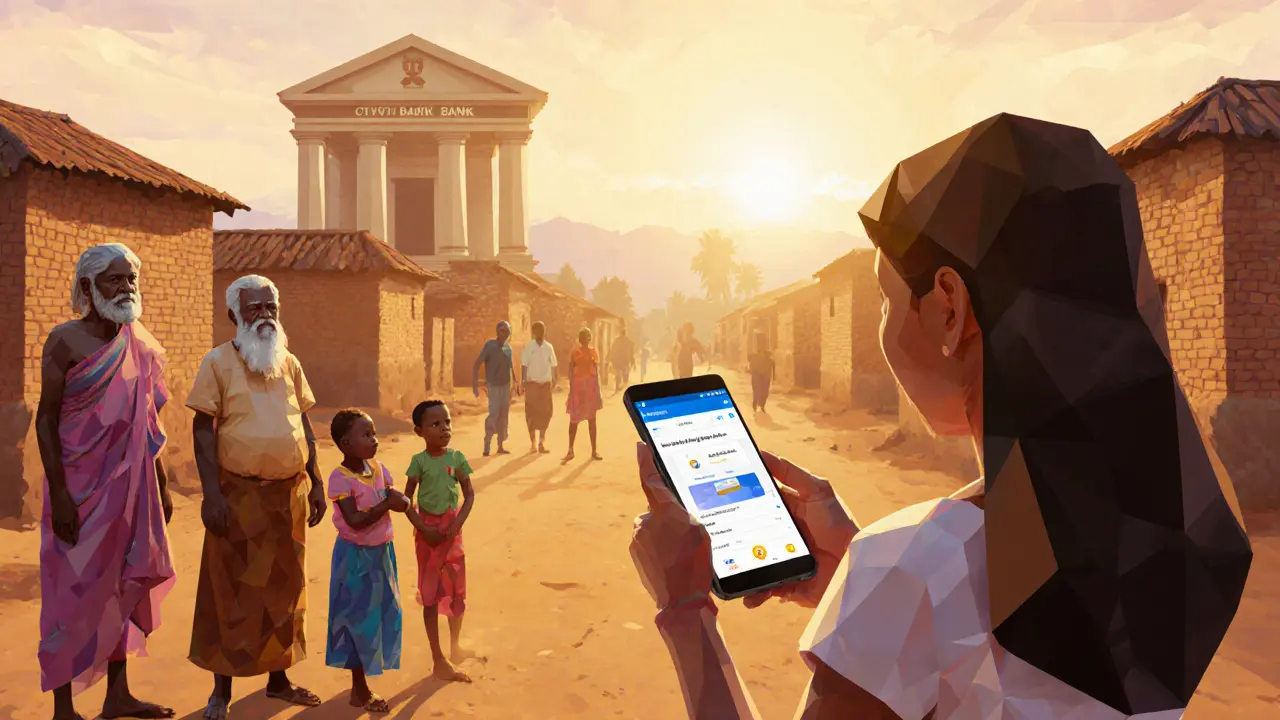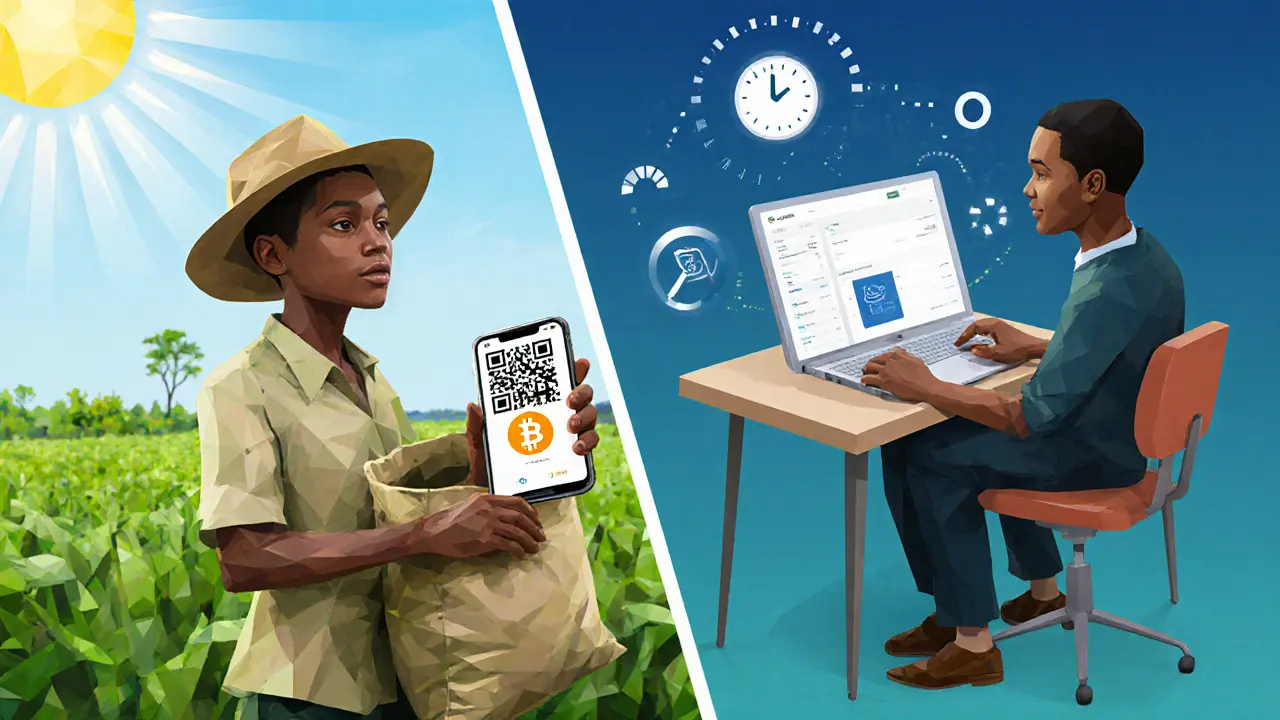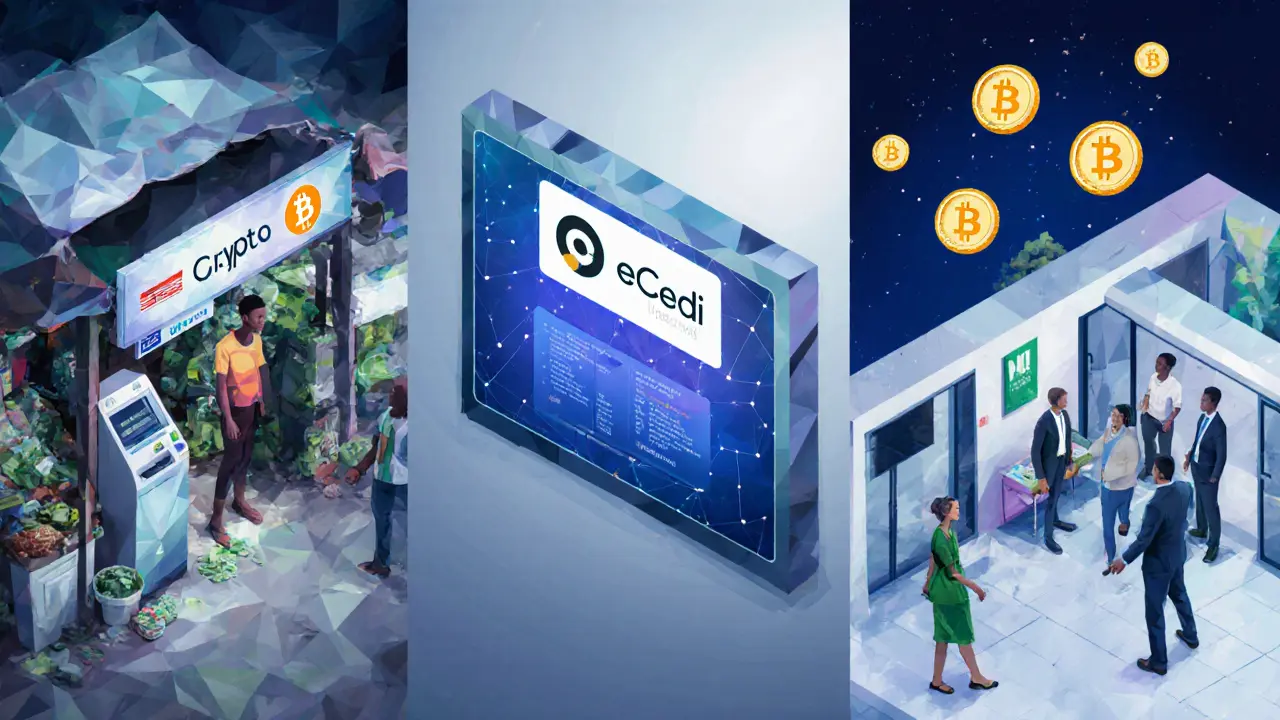How Cryptocurrency Can Boost Financial Inclusion in Developing Countries

Remittance Cost Calculator
Compare Remittance Costs
Your Savings
Based on article data: Traditional fees 6-15% vs Cryptocurrency fees under 1%
Millions of people in low‑income economies still lack basic banking services. Traditional banks demand paperwork, minimum balances, and physical branches that simply don’t exist in many rural areas. cryptocurrency offers a shortcut: a digital, decentralized system that works on a smartphone and an internet connection. This article explains how crypto can break the barriers that keep the world’s unbanked out of the financial system, what challenges still need solving, and which real‑world projects are already making a difference.
What cryptocurrency actually is
Cryptocurrency is a digital asset secured by cryptography and recorded on a distributed ledger called a blockchain. Unlike fiat money, it isn’t issued by a central bank, so no single authority can block or reverse a transaction.
Why blockchain matters for inclusion
Blockchain is the underlying technology that provides a decentralized, tamper‑proof record of all transactions. Its peer‑to‑peer nature means anyone with a device can join the network without asking for permission.
This decentralization removes the need for costly infrastructure-no vaults, no branch networks, no legacy IT systems. All that’s required is a smartphone with internet access, making the technology especially appealing in regions where banks are scarce but mobile penetration is growing.
Core financial services crypto unlocks
- Digital wallet is a software application that lets users store, receive, and send crypto without a bank account. Wallets can be created in seconds, often without identity verification.
- Remittances become near‑instant and cost under 1% of the amount transferred, compared with 6‑15% charged by traditional money‑transfer operators.
- Inflation hedge - cryptocurrencies like Bitcoin have a fixed supply, offering a store of value when local currencies lose purchasing power.
- Tokenization allows small businesses to issue digital assets, opening new financing channels that bypass conventional credit systems.
How it works on the ground
Imagine a farmer in rural Kenya who must travel two hours to the nearest bank. With a basic Android phone, the farmer installs a crypto wallet, receives Bitcoin from a relative abroad, and instantly pays for fertilizer through a QR code. No paperwork, no travel, and no hidden fees.
In Nigeria, a young entrepreneur uses a stablecoin pegged to the US dollar to pay overseas suppliers, avoiding the 20% foreign‑exchange markup that local banks impose. The transaction settles in minutes, freeing cash flow for expansion.

Comparing traditional banking and cryptocurrency for inclusion
| Feature | Traditional Banking | Cryptocurrency |
|---|---|---|
| Account opening | Requires ID, proof of address, minimum balance | Instant wallet creation, no ID needed |
| Physical access | Branch needed, often >10 km away | Mobile phone + internet enough |
| Transaction cost (domestic) | 0.5‑2% per transfer | Usually <1% (network fee) |
| Cross‑border fees | 6‑15% + days to weeks | Under 1% + minutes |
| Inflation protection | Depends on local currency stability | Fixed‑supply assets (e.g., Bitcoin) act as hedge |
| Regulatory oversight | Well‑established, consumer protections | Varies; often unclear in developing markets |
Key barriers to widespread adoption
Despite the promise, adoption isn’t universal. The biggest hurdles fall into four buckets:
- Regulatory uncertainty - many governments lack clear crypto laws, creating fear among users and businesses.
- Infrastructure gaps - unreliable internet and limited smartphone penetration still affect remote villages.
- Security & literacy - managing private keys is technical; a lost key means lost funds.
- Market volatility - price swings can erode confidence, especially for low‑income households that can’t absorb losses.
Addressing these challenges requires coordinated effort from policymakers, NGOs, and tech providers.
Successful pilots and emerging trends
Several projects illustrate how crypto can move from theory to practice:
- Kenya’s “Crypto‑Cash” program - partners local mobile money operators with crypto wallets, allowing users to convert Bitcoin to KES at the point of sale.
- Ghana’s e‑Cedi pilot - the central bank is testing a state‑backed digital currency designed for low‑cost payments and financial inclusion.
- Tokenized micro‑loans in Nigeria - fintech startups issue blockchain‑based loan tokens to small traders, bypassing traditional credit scoring.
These pilots share a common recipe: combine crypto’s speed with local partnerships that provide education and on‑ground support.

Practical steps for governments and NGOs
If you’re part of an organization looking to boost inclusion, consider the following checklist:
- Define a clear regulatory sandbox - allow pilots under monitored conditions to gather data without full‑scale risk.
- Invest in digital infrastructure - subsidize affordable data plans and distribute low‑cost smartphones.
- Launch education campaigns - teach wallet basics, private‑key safety, and how to spot scams.
- Partner with existing mobile money networks - integrate crypto gateways to leverage established trust.
- Mitigate volatility - promote stablecoins or hedging services for everyday transactions.
Future outlook
Analysts expect cryptocurrency to keep growing as a niche tool for specific inclusion scenarios-most notably cross‑border remittances and inflation‑prone economies. Success hinges on three forces:
- Regulatory clarity - balanced rules that protect consumers without stifling innovation.
- Technology diffusion - wider internet coverage and cheaper devices.
- Financial literacy - sustained education that demystifies crypto for everyday users.
When these align, crypto could lift millions out of the “unbanked” category, fueling entrepreneurship, reducing poverty, and widening the global economic pie.
Quick Takeaways
- Cryptocurrency lets anyone with a phone join the financial system without a bank.
- It dramatically cuts the cost and time of cross‑border remittances.
- Fixed‑supply tokens provide a hedge against hyper‑inflation.
- Regulation, infrastructure, security, and volatility remain the biggest adoption hurdles.
- Successful pilots blend crypto tech with local partnerships, education, and stablecoins.
Can I use cryptocurrency without a bank account?
Yes. A digital wallet can be set up on a smartphone in minutes, and no bank account or proof of address is required for most wallets.
How much does a crypto remittance cost?
Network fees are usually under 1% of the transaction amount, far cheaper than the 6‑15% charged by traditional money‑transfer services.
Is cryptocurrency safe for low‑income users?
Safety depends on how users manage private keys and choose reputable wallets. Education on key storage and phishing protection is essential.
What about price volatility?
Volatility is a real risk. Many programs use stablecoins-cryptocurrencies pegged to a fiat currency-to lock in value for everyday purchases.
How can governments support crypto‑driven inclusion?
By creating sandbox regulations, investing in broadband, partnering with mobile operators, and running public‑education campaigns on digital finance.

Rebecca Kurz
October 19, 2025 AT 08:21Crypto is just the government’s secret way to track us!!!
Nikhil Chakravarthi Darapu
October 28, 2025 AT 16:12India cannot sit on the sidelines while the West pushes crypto as a tool for neo‑colonial control. Our sovereign tech must rise, built by Indians for Indians. The narrative that crypto is only for the rich is a lie propagated by foreign interest groups. We need national policies that empower our people, not lecture them.
Tiffany Amspacher
November 7, 2025 AT 01:02I see the digital tides rising, and the unbanked are the forgotten sailors longing for a compass. Cryptocurrency, they say, is the lighthouse-yet, who holds the flame? If we surrender our trust to code, are we not echoing the ancient myths of Prometheus stealing fire? The promise of freedom glitters, but the shadows whisper caution. Still, hope flickers in every farmer’s pocket, a promise of dignity. Perhaps the true revolution is not the tech, but the belief that we are worth the risk.
Lindsey Bird
November 16, 2025 AT 09:53So you’re telling me crypto is a miracle cure for the unbanked? Sure, if you love waiting for a blockchain to confirm a payment while your crops wilt. The hype feels like another marketing gimmick, dressed up in buzzwords. I’m not buying the fantasy that a phone can replace a bank’s infrastructure overnight. Honestly, it feels lazy to think software alone can fix all those systemic problems.
john price
November 25, 2025 AT 18:43I think crypto could be a tool, but lets be real-this is not a magic wand. The article glosses over the fact that many peopel dont even have reliable internet. You cant just hand out wallets and expect economic boom. It's a naive oversimplification that ignores the real world, and the author needs to stop romanticizing tech. Plus, the security risks are massive, and most users cant protect themselves.
Ryan Steck
December 5, 2025 AT 03:34They don't tell you the hidden agenda-crypto is just another way for the elite to control us!!! The governments are watching every transaction, even the ones you think are private. And the misspelled 'stablecoin' thing? That's just a smokescreen! Wake up!
James Williams, III
December 14, 2025 AT 12:25From a technical standpoint, the reduced transaction costs stem from the elimination of intermediary layers, which traditionally add markup. When you compare the fee structures-6‑15% for remittance firms versus sub‑1% for blockchain transfers-the savings are evident. Moreover, the scalability solutions like Lightning Network for Bitcoin or Layer‑2 rollups for Ethereum further decrease latency and cost. In practice, this means a farmer can receive more of the money sent from abroad, directly impacting productivity. The key challenges remain regulatory clarity and user education, but pilot programs in Kenya have shown promising adoption rates. If we continue to invest in infrastructure and localized wallet solutions, the network effect will drive even lower fees over time. So, the technology isn’t just hype; it has measurable economic benefits.
Patrick Day
December 23, 2025 AT 21:15Crypto is just another experiment, and most of us don’t have the luxury to test it. The internet is flaky, and a single glitch can lose your funds. Better stick with what works.